Two Seoul Neighborhoods: Ikseon-dong & Bukchon Hanok Village
Should old neighborhoods always be preserved? How do you preserve a neighborhood without it becoming just a re-creation of its former self?
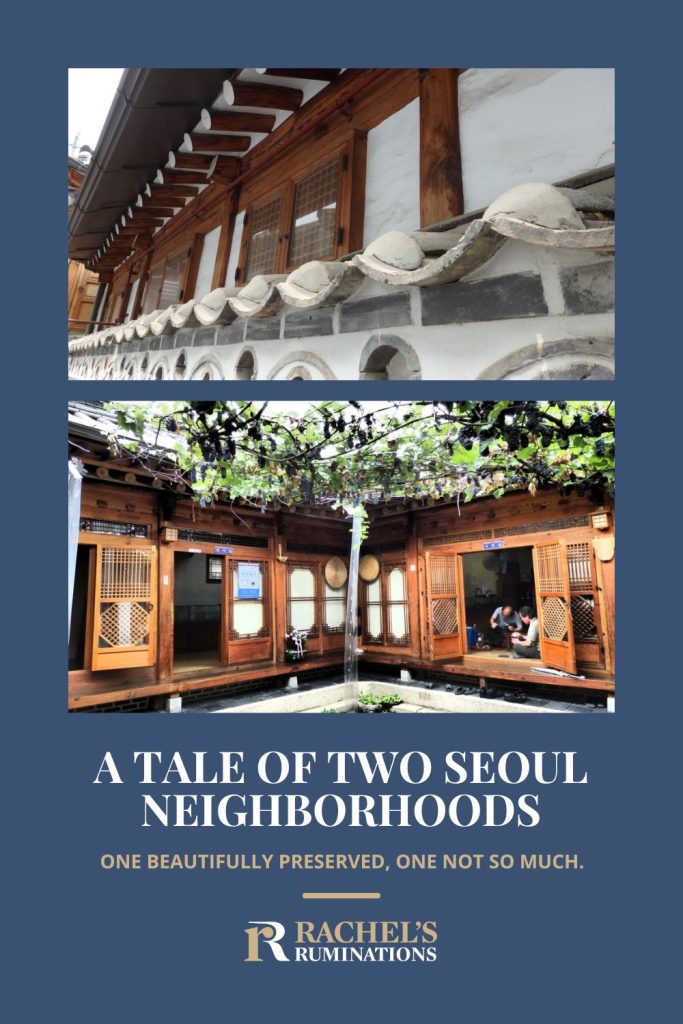
Disclosure: This article contains affiliate links. If you click on one and make a purchase, I will receive a small commission. This will not affect your price.
[Last updated October 11, 2025]
When I checked into the Hotel Ibis Insadong in Seoul, South Korea, I was immediately fascinated by the view from my window. The hotel overlooks the Ikseon-dong Hanok Area, or perhaps I should say it looms over it.
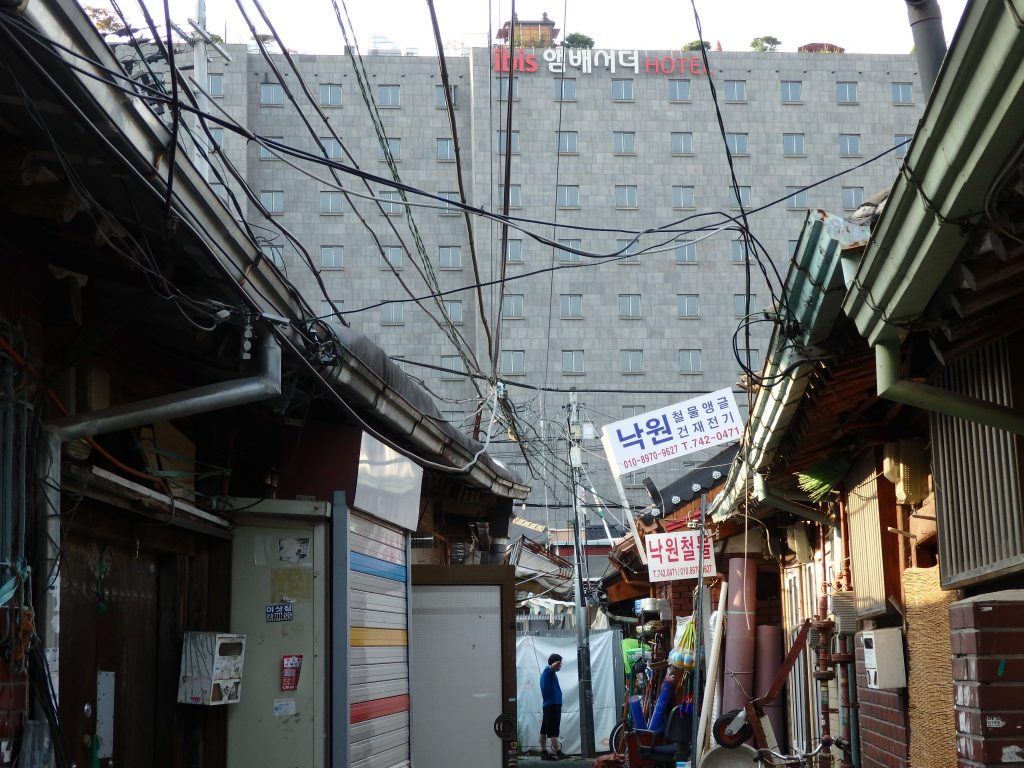
Ikseon-dong Hanok Area
The neighborhood looks from above to be about a city block around, and is filled with small, single-story, traditional Korean buildings, called hanoks. Many have the typical curved roof lines, with tiling supported by wood beams. From above, some appear to be in poor shape, with roofs that have been repaired and patched, sometimes with what looks like scraps of tarp.
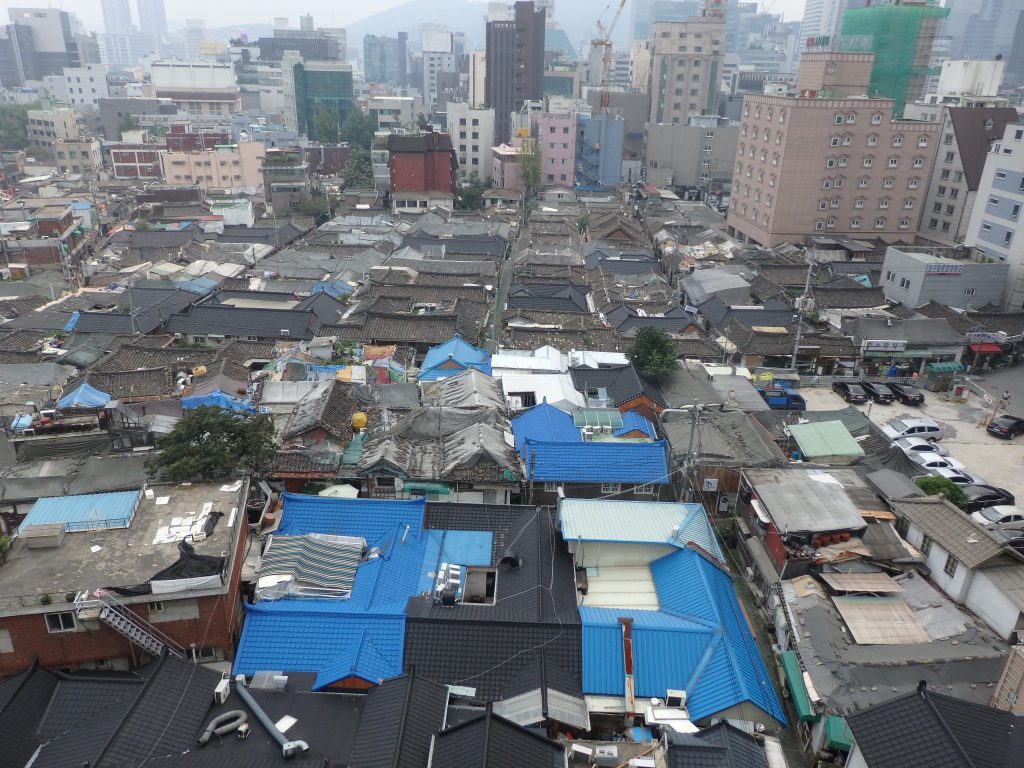
Exploring the neighborhood on foot confirmed my first impression. While some of the houses have been restored, many make a rundown impression. A few have the traditional plaster with decorative elements in tile, but many have been changed with the addition of plain tiling or concrete or other materials. A few contain businesses catering to tourists or young people, running teahouses or restaurants. Some clearly supply the more prosaic everyday necessities or cheap food. Most, though, seem to still be homes.
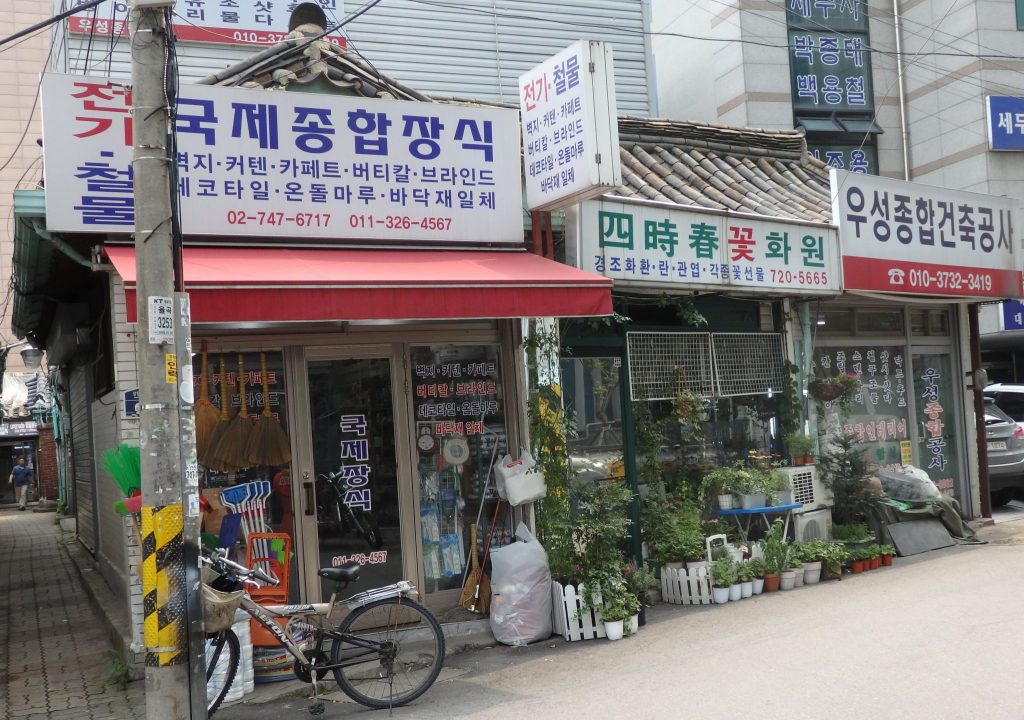
Strolling along the narrow alleyways – too narrow for cars, but motorcycles and scooters are everywhere – I could still glimpse here and there the traces of Seoul’s past in these homes . . . if I just ignored the tangles of electric wires, the external plumbing, the utility meters, and so on.
This neighborhood was built in the 1930s, when Seoul was occupied by the Japanese and population pressure led to the development of tightly-packed hanok neighborhoods. And judging from the view from my hotel, the neighborhood is in imminent danger of disappearing, swallowed up by the growing city on all sides. Yet recent magazine articles tell of hopeful changes coming to the community. Some hanoks have been refurbished and aim for a chic end of the market. Some have become galleries.
Note added October 2025: I just did a quick search online for more recent pictures. While it looks like the tangles of wires remain, some of the buildings have been renovated and trendy shops have appeared within this hanok area.
You might also enjoy these articles about South Korea:
Bukchon Hanok Village
Bukchon Hanok Village is another section of Seoul, a fifteen-minute walk from Ikseon-dong. Also built in the 1930s for the same reason as Ikseon-dong, this “village,” shows the results of a joint effort between the city government and local residents to preserve what is left of the traditional hanok housing. This comes after a period in the 1980s and 90s when many were destroyed in favor of multi-unit buildings. Like Ikseon-dong, it contains many hanoks, but it has a completely different feel to it.
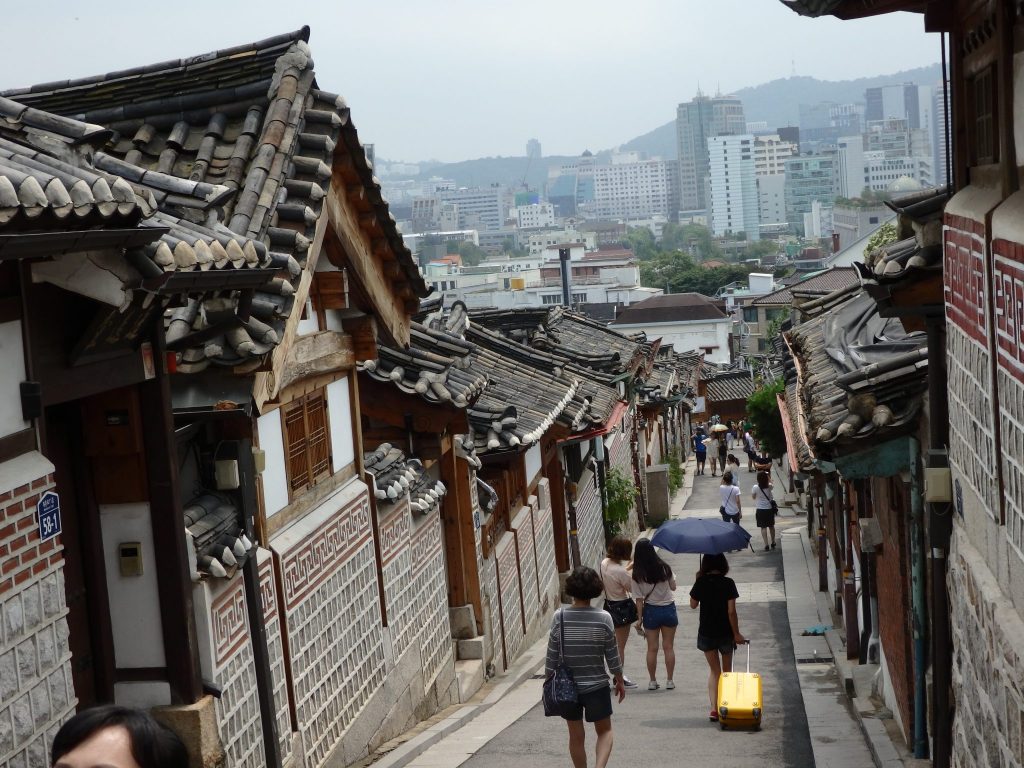
These houses are in good repair and appear closer to the traditional hanok. Many have the plaster with prettily-inset tile fragments lining their outside walls, or neat brick or stone work.
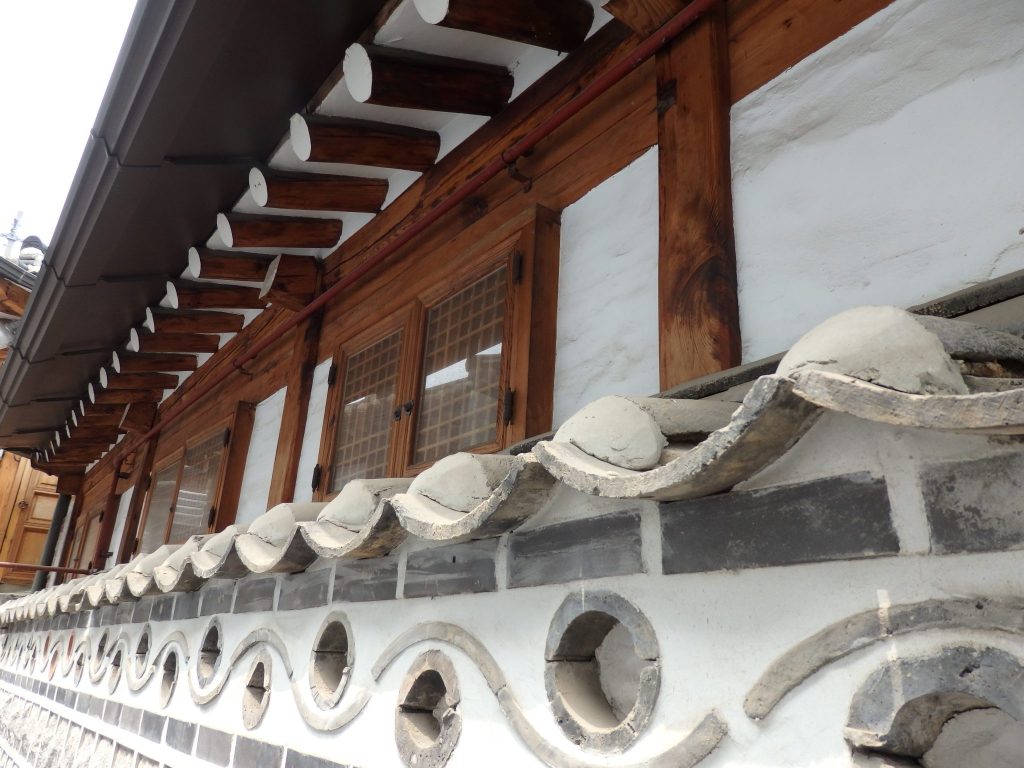
The electric wires above the streets are minimal and don’t hang low. The streets are clean and many of the homes have trees peeking over the walls or framing their doors.
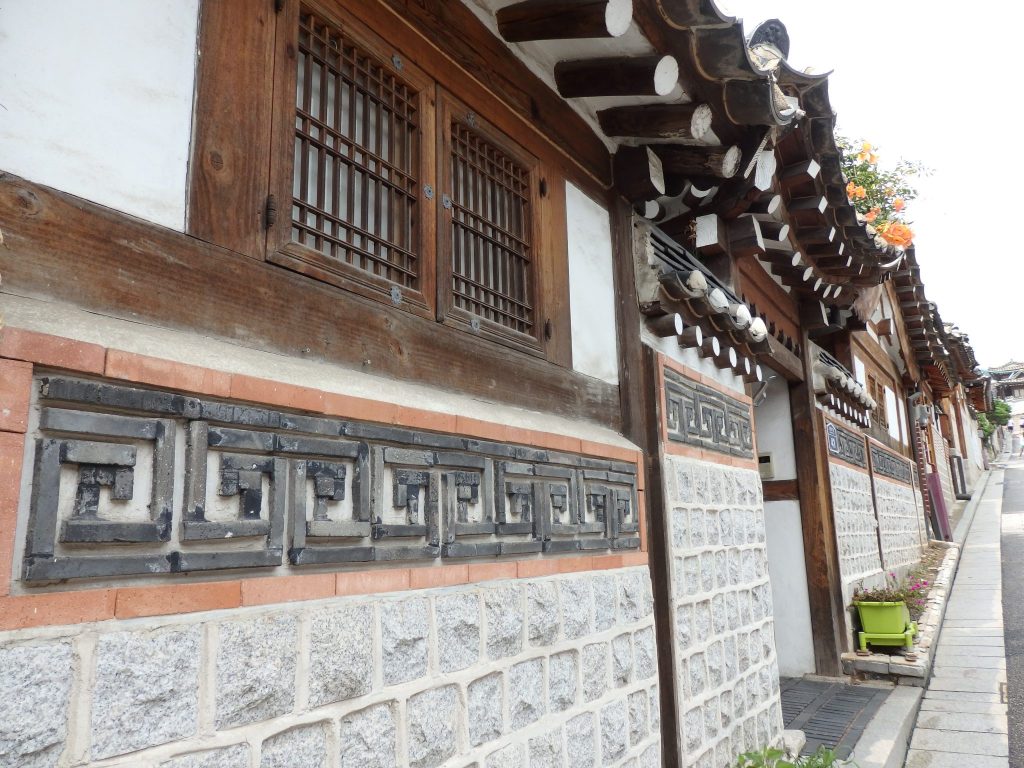
Some of the hanoks in Bukchon appear to be brand new, judging by the light color and pristine state of the wood. Nevertheless, they were obviously built to the older traditional style.
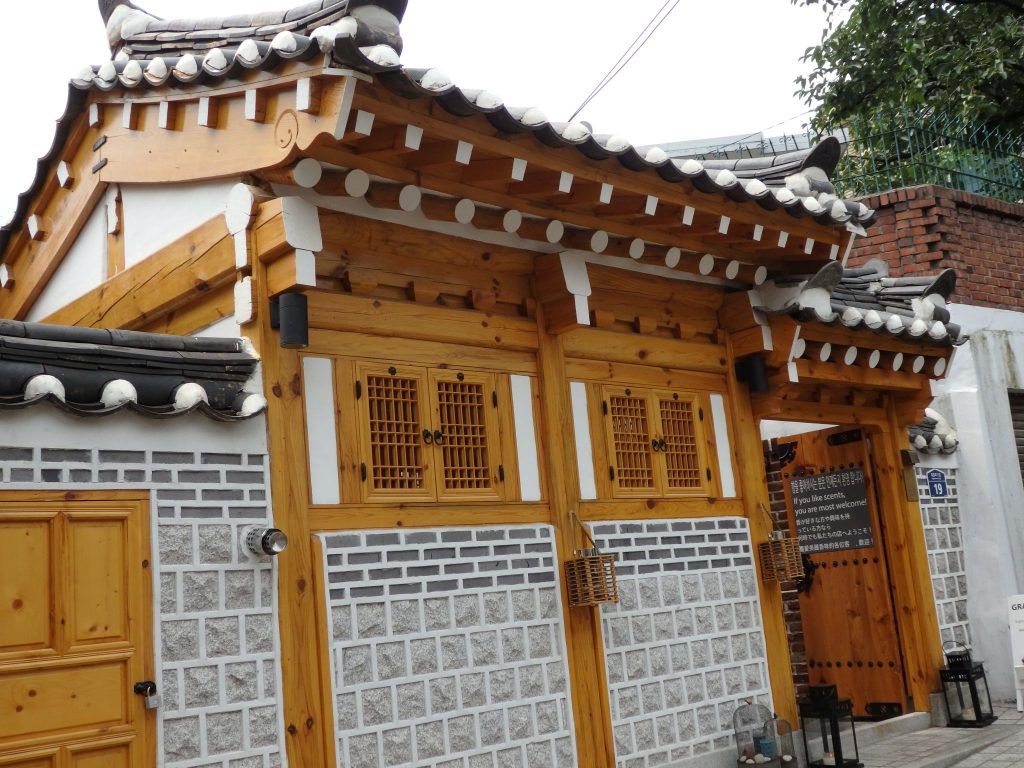
The area is hillier, and strolling the streets can lead to some great views over the roofs of the hanoks.

Many of these are homes, clearly higher-end homes than in Ikseon, of course. Some of them are being used for “home stays,” though I don’t know how many of these are really people’s homes, or function more as very small hotels.
Bonum 1957 is a boutique hotel in a traditional-style hanok house in Bukchon. So are Nostalgia Hanok Hotel and AWIK Hanok Stay and many others.
Bukchon is also home to various museums and workshops catering to visitors, some of which are housed in hanoks. This is a partial list:
- Donglim Knot Workshop: demonstrates traditional knot-tying craftwork
- Bukchon Traditional Culture Center: museum with displays about the history and architecture of Bukchon
- Han Sang Soo Embroidery Museum
- Gallery Giotta (formerly Gallery W Gahoe): contemporary arts
- HANSIK Space E:eum: gallery focused on food and alcohol, with tasting sessions.
The day I explored Bukchon, the place that appealed to me most was the Bukchon Traditional Crafts Experience Center, which gives visitors the opportunity to try out some traditional Korean crafts: different ones each day of the week. On the day I visited, a Sunday, three options were available: painting a t-shirt (with a traditional drawing on it), making traditional paper slippers, or tie-dying a handkerchief. I chose the t-shirt. It was pre-printed with a design of a horse which appeared to have flames emerging from it.
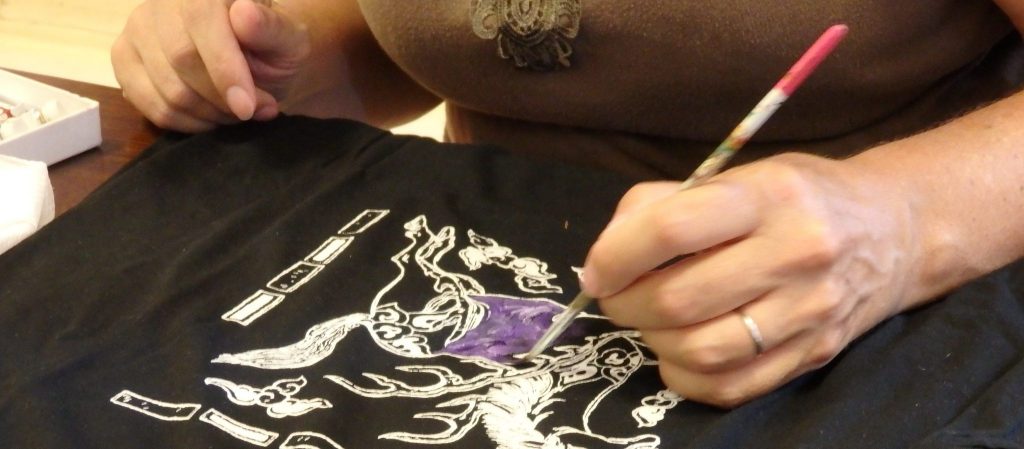
I searched Wikipedia, the font of all knowledge, later, and I think the horse is meant to be Chollima. According to Wikipedia, when the people of the mythical kingdom of Silla “gathered to pray for a king, the horse emerged from a bolt of lightning, bowing to a shining egg. After the horse flew back to heaven, the egg opened and the boy Park Hyeokgeose emerged. When he grew up, he united six warring states.”
I spent a very pleasant hour using paint fabric dye to fill in the line drawing on the shirt.
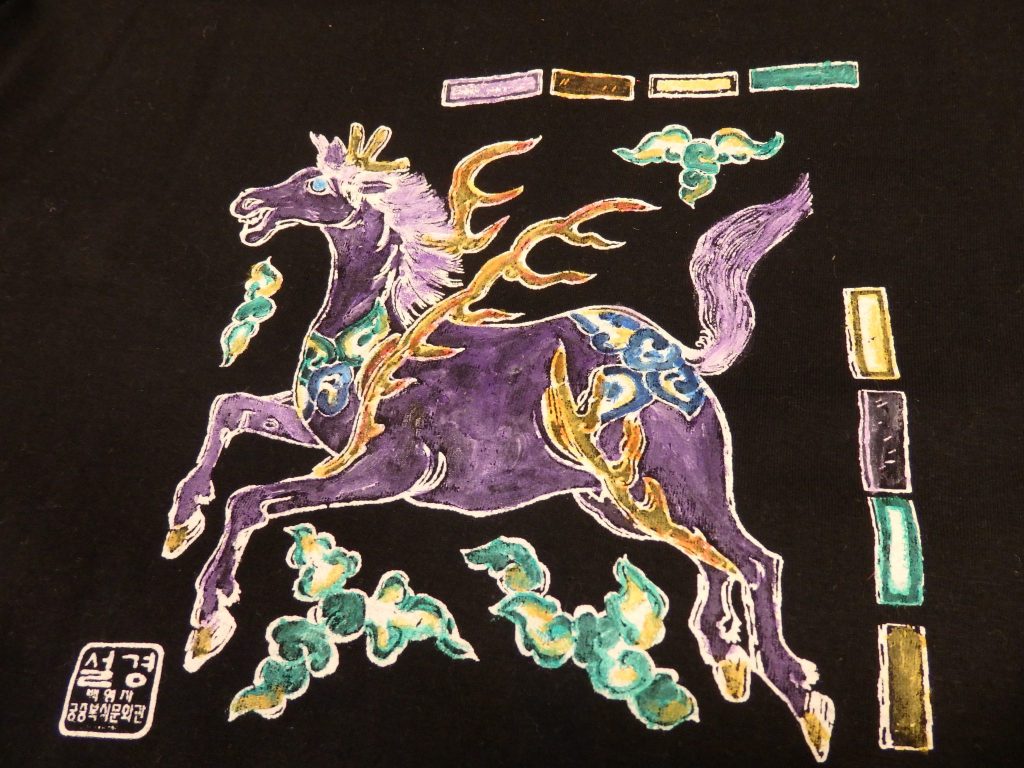
Bukchon and Ikseon-dong are both hanok neighborhoods, both representatives of Seoul before its post-Korean War modernization. Few such homes remain in this city, and very few whole neighborhoods.
Book accommodations in or near Bukchon Hanok Village here.
The question is whether any will remain at all, given the pressure of population growth. I don’t know anything about local politics or decision-making about preservation of older buildings, but from outward appearances, looking down on it from my hotel room, I feared that the Ikseon-dong Hanok Area might be doomed, yet it is still there, years later. Bukchon, on the other hand, will remain, but I fear it will increasingly become a disneyfied version of old Korea.
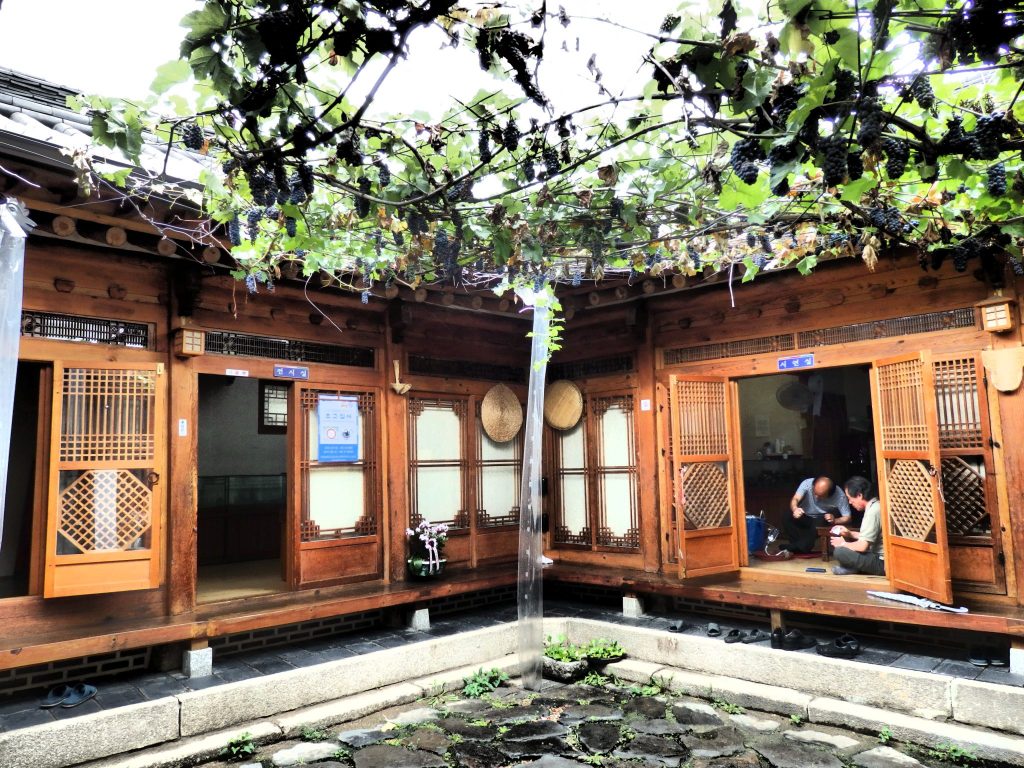
What do you think? Should old neighborhoods always be preserved? How do you preserve a neighborhood without it becoming just a re-creation of its former self?
My travel recommendations
Planning travel
- Skyscanner is where I always start my flight searches.
- Booking.com is the company I use most for finding accommodations. If you prefer, Expedia offers more or less the same.
- Discover Cars offers an easy way to compare prices from all of the major car-rental companies in one place.
- Use Viator or GetYourGuide to find walking tours, day tours, airport pickups, city cards, tickets and whatever else you need at your destination.
- Bookmundi is great when you’re looking for a longer tour of a few days to a few weeks, private or with a group, pretty much anywhere in the world. Lots of different tour companies list their tours here, so you can comparison shop.
- GetTransfer is the place to book your airport-to-hotel transfers (and vice-versa). It’s so reassuring to have this all set up and paid for ahead of time, rather than having to make decisions after a long, tiring flight!
- Buy a GoCity Pass when you’re planning to do a lot of sightseeing on a city trip. It can save you a lot on admissions to museums and other attractions in big cities like New York and Amsterdam.
Other travel-related items
- It’s really awkward to have to rely on WIFI when you travel overseas. I’ve tried several e-sim cards, and GigSky’s e-sim was the one that was easiest to activate and use. You buy it through their app and activate it when you need it. Use the code RACHEL10 to get a 10% discount!
- Another option I just recently tried for the first time is a portable wifi modem by WifiCandy. It supports up to 8 devices and you just carry it along in your pocket or bag! If you’re traveling with a family or group, it might end up cheaper to use than an e-sim. Use the code RACHELSRUMINATIONS for a 10% discount.
- I’m a fan of SCOTTeVEST’s jackets and vests because when I wear one, I don’t have to carry a handbag. I feel like all my stuff is safer when I travel because it’s in inside pockets close to my body.
- I use ExpressVPN on my phone and laptop when I travel. It keeps me safe from hackers when I use public or hotel wifi.


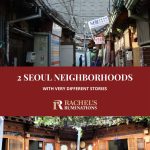


Gorgeous pictures! I have a friend who taught English in Seoul for a year after grad school, and she’s always talking about how much she loved it there. Your post makes it easy to see why! 🙂
Thanks, Nathalie! I’m glad you liked it!
Hi Rachel
I’ve wandered through Buckchon a few times over the years.The hanoks have definitely been rebuilt beautifully, but leave me a bit cold. I was surprised at the Ikseon hanok area. I wasn’t aware of its existence. I think it’s much more interesting to poke around in than Buckchon. I do hope that the neighborhood doesn’t go the way of the wrecking ball. I also hope that the residents get to stay and are not shunted off somewhere so that another tourist attraction can be built.
Ikseon was mostly very local and somewhat run-down, but with some businesses meant for visitors from outside: a tea-room, some restaurants, a few galleries, etc. I think it could go either way. Both are mostly residential, but one has locals walking around outside while the other has tourists.
I think it is good to preserve certain neighborhoods because of the historic significance of them or because of the cultural impact they had on a city. But, I think there are many more reasons to preserve. Like you mentioned, the areas can be “preserved” by giving it a new life. I have seen old neighborhoods that have been revived by businesses, art and other events.
Yes, but I’d rather have them revived for the benefit of locals rather than tourists. It shouldn’t just be a façade maintained in order to attract visitors. Bukchon seems to have moved that way, whereas Ikseon seems, from my outsider’s view, more like a living neighborhood. Yet it also seems distinctly more threatened.
When there are so few of the original houses left I think all attempts should be made to save them.
Me too!
Lovely photos…
Thank you!
I love the above shot, and you think ok. Then you take us to the ground and walk us around, and I think, oh yes. I love the living neighbourhood of Ikseon, but I also understand the position of Bukchon. These are the dilemmas, for them and for us,
Exactly! Ikseon was more lively and interesting. Bukchon was more beautiful, but duller. I enjoyed both!
Wow! Bukchon seems so much nicer! I love your tee-shirt. My daughter would approve of the purple horse. Thanks for linking up with #Wednesday Globetrot!
Bukchon is definitely prettier, but I saw more tourists than locals there. I gave the t-shirt to my son but haven’t seen him wear it even once. Maybe I’ll claim it back…
I think old neighborhoods should always be preserved as much as possible however from my experience, sometimes the locals themselves, don’t want to do so.
I remember when I first came to Berlin in the 90’s, my first apartment was near the river, huge, had an extra attic, had high ceilings, still had a coal-based oven and no bathroom. We put the bathtub in the living as a piece of artistic decoration…! Anyway, as Berlin became trendy, Germans from other parts of the country refused to live in such “uncivilised” conditions and the 1890 building was given an overhaul and basically sold off to developers. Now that particular apartment is for sale for €380,000!